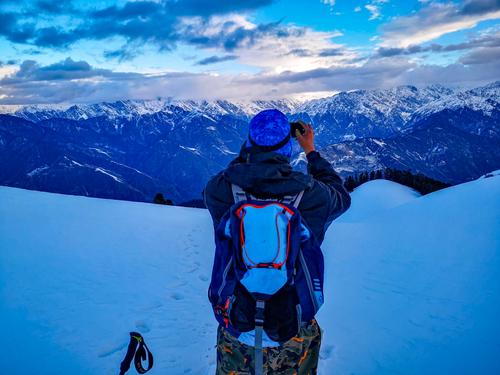Kedarkantha Trek





Starts From
₹ 9500/-
About The Trip
Plan The Unplanned brings you one of the best Himalayan Winter treks available, suitable for both first-time Himalayan trekkers and experienced trekkers looking for a quick Himalayan getaway. If you've always wanted to trek through the snowfields of the Himalayas and gaze at the mighty peaks kissing the sky, this is the trek for you! There are very few treks in the Indian Himalayas that claim to be easy summit treks.
Summit climbs are generally difficult, requiring technical mountaineering skills as well as extensive planning. However, Kedarkantha is one of those rare summit treks that can be completed by beginners and even during peak winter months. Winter treks are few and far between, which makes the Kedarkantha trek all the more appealing. With snow falling over numerous pine trees, the entire landscape is magical, making Kedarkantha one of the most sought-after treks in the Indian Himalayas.
During the winter, trekkers can enjoy snowy campsites as well as a fresh snowfall. And the feeling of summiting a peak is unparalleled, making it extremely dangerous.
Price
Tickets

Starting From : INR 10000/-
INR 9500/-
per person
Tickets
 Download PDF
Download PDF
Brief Itinerary
Inclusions & Exclusions
Inclusions
Exclusions
Detail Itinerary
All Meals
Car
Tents | (Triple Sharing Basis)
Details
Distance: 220 km
Time took: 10 – 11 hours
Leave Dehradhun at 6:30 a.m. and get to Sankri at 5:30 p.m. Sankri is a small pretty village. Some shops and dhabas make Sankri. Most trekkers get to Sankri in the evening, which is a good time to watch the sun set over the Greater Himalayan mountain ranges. In the evening sun, the peaks of Swargarohini shine and stand tall over the ridges beyond Sankri.
All Meals
Trek
Tents
Details
Altitude: 9,100 feet
Distance: 4 km
Time taken: 5 hours
Take the paved road out of Sankri until you reach Sol village, which is an outpost of Sankri. The road curves sharply after you pass through the village. After about 7-8 minutes, look to your right for a trail that climbs steeply and runs next to a stream. The path that leads to Kedarkantha is this one. When in doubt, watch for a passing local and ask for directions. After entering a pine forest, the trail immediately begins to climb steeply until, ten minutes later, you reach a ridge. The trail widens and evens out on the ridge for almost the remainder of the day.
After an hour, look to your right for a small wooden bridge. Beyond the bridge, about 40–50 metres higher on the trail, is a shepherd's hut that can be seen. You are now one-fourth of the way to Juda-ka-Talab.
The stream you have been hearing eventually catches up with you. Fill up your bottles at this final water source to last until Juda-ka-Talab, which is another 1,000 feet higher and another two and a half hours away.
The trail that runs to your left is clearly visible and forks at the stream, so keep going there instead of taking the one that crosses the bridge. Look for a large tree trunk that has fallen to the ground in a large grove of Maple trees 30 minutes later. The southern edge of the clearing mysteriously draws you into a shadowy forest beyond the tree. You are halfway through your trek to Juda-Ka-Talab at 8,100 feet. To return to the sparse pine and maple forest on its northern edge, continue on the trail through the clearing. The trail ascends quickly through dense oaks through a series of switchbacks before finally coming out in the open over a rising mound to welcome you to the magnificent campsite of Juda-Ka-Talab.
Juda-Ka-Talab's as a campground is almost too ideal. The sizable lake, which was once two lakes but has since been joined as one, is on your left, and the thick edge of an oak and pine forest is on your right. The light hardly ever penetrates the forest because it is so dense. The clearing and campsite of Juda-Ka-Talab are formed by a number of gently undulating mounds. The ridge line, which is high above and to your left, is where the afternoon sun enters. One of the densest pine forests you will ever see completely covers the area, casting shadows everywhere.
All Meals
Trek
Tents
Details
Altitude: 11,250 feet to 12,500 feet to 9,100 feet
Distance: 6 km
Time taken: 6 – 7 hours
The exit from Juda Ka Talab is a straightforward, well-lit path. The path ascends to a ridge near the lake's edge. Take a sharp left turn and enter a dense pine forest as you climb higher at the ridge. Even though the lake is not visible, the trail continues to veer left, staying on the slope directly above Juda Ka Talab. The trail quickly gains 800 feet over Juda Ka Talab and, after another 30 minutes, emerges at a ridge. The ridge begins to flatten, mostly in the company of oaks.
As you near the edge of the meadow while still on the ridge, begin another steep climb through the oaks. A further open meadow with a lone shepherd's hut appears on your right after 30 minutes on the ridge (Hut Point). The surroundings are breathtakingly lovely and necessitate a break from the trek. From here to the base of Kedarkantha, you have to ascend less than 1,000 feet. After a brief ascent through the oaks' shade, the trail emerges into a sizable clearing that has a second shepherd's hut on its northern edge. Your first breathtaking 180-degree view of the snow ranges encircling the Kedarkantha summit is behind you.
Under the parched oak trees, the trail reverses course and heads north. The trail gently ascends to another clearing in two stages, typically over snow. You have arrived at the location of the Kedarkantha base camp, which is identified by another crumbling shepherd's hut.A broad arc of white peaks can be seen extending from your left to your right. Among the dozens of others, Bandarpoonch, Swargarohini, Kala Nag, and Ranglana stand out.
Note: It is extremely cold and frequently windy outside. Carry enough wool clothing to keep you warm and dry.
All Meals
Trek
Tents
Details
There is no better reason to drag yourself out of your sleeping bag than to watch the sunrise over Kedarkantha Base. From the KK Base, the Kedarkantha peak is clearly visible. Numerous trails lead to the summit. The best way to get to the Kedarkantha summit is to ascend using a series of switchbacks along the northern ridge of the summit. From the Kedarkantha base campsite, the summit can be reached in an hour and a half.
A square arrangement of stones featuring a Trishul that points upward designates the Kedarkantha summit. The summit, which towers over the surrounding area, offers a 360-degree view of Uttarakhand's impressive snow-covered mountain ranges. From the summit, it is easy to see the Gangotri, Yamunotri, Chanshil Pass, and Kinnaur Kailash ranges. Take a different path to your camp after leaving the summit by following Kedarkantha's southern ridge. A simple ridge descent leads to the oak forest below. Many trekkers prefer to ascend Kedarkantha from the southern ridge and descend by the northern side, depending on the amount of snow. The southern ridge has less snow, which makes climbing easier. Choose a route based on the snow, as both take about the same amount of time.
By noon, return to your Kedarkantha base camp location, and no later. Lunch will be served at the campsite upon arrival. As it is the final night at the campground, we will throw a celebration.
Spend the night at the Juda ka Talab campsite.
Details
Descending 2500 feet through dense pine forests following an early breakfast, we will descend from Juda ka Taal towards the Sankri Village.
After arriving in Sankri, we'll stop at our designated hotel to freshen up and have lunch there.
We'll then proceed to Dehradun shortly thereafter. (Arrive in Dehradun in the late evening)
Here, the group will disperse and go their separate ways with hearts full of contentment and minds brimming with memories.
Things To Carry
Backpack (Minimum 55 Ltrs with rain cover): Choose a high-quality backpack with a comfortable fit and straps that do not cause shoulder pain. For a quality trekking backpack, you can visit the nearest Decathlon location.
Daypack (20 - 30 Ltrs): When ascending to the summit, you are required to carry only a few essential items; therefore, you will need a daypack since you will leave your larger pack at the campsite.
Floaters or sandals: Although the entire trek requires sturdy footwear, your feet must be able to breathe to prevent chafing and blisters. A good pair of sandals and floaters will allow you to move freely in the camp.
Good trekking footwear is comfortable, provides ankle support, and has excellent traction. Instead of being bulky, they should be lightweight and durable.
3 Pairs of Quick-Dry T-Shirts: You must carry at least three pairs of quick-dry t-shirts so that you can launder them between stops for the sake of hygiene.
Quicky DryTrek Pant: A high-quality pair of polyester track pants will allow your skin to breathe. They are lightweight, quick-drying, and comfortable for walking. You can avoid chafing and rashes by purchasing a quality pair of track pants.
3 Pairs of Cotton Socks: Cotton socks are extremely lightweight and comfortable to move around in, so you can always rely on a good pair of cotton socks while trekking. However, remember to replace them frequently and avoid wearing them when they are wet.
1 Pair of Woolen Socks: A quality pair of woollen socks, preferably merino, is comfortable, inhibits odours, and provides sufficient insulation from the cold so that they can be worn at night.
1 Poncho: A poncho is an evolved form of a raincoat that protects both your body and your belongings from the rain.
Padded/Heavy Jacket: It is emphasized that you must bring appropriate layers to avoid getting cold; therefore, you must bring a heavy jacket that can be worn over your other clothing.
Thermal is a type of clothing that aids in keeping the body warm during cold weather. A high-altitude trek necessitates the use of this essential item.
A towel that dries quickly will aid in maintaining proper hygiene. The wet fabric increases the likelihood of bacterial growth; therefore, it must dry quickly.
Windbreaker Jacket: As you ascend to a high altitude, you are subjected to chilly winds, which a windbreaker jacket is designed to repel. They are made of lightweight synthetic fibres.
Woolen Cap: When ascending to a high altitude, a woollen cap will help prevent the onset of frostbite. When travelling at high altitudes, you can also cover your ears to prevent any pain and discomfort you may experience in them.
Insulated gloves help maintain proper body temperature in the hands and provide a better grip on trekking poles.
Sun Cap: A lightweight sun cap with side flaps is ideal for preventing sunburns and keeping your head cool on sunny days.
1 Scarf or Balaclava: In addition to sun rays and chilly winds, you are also exposed to dirt and grime during treks; therefore, it is essential to carry a scarf or balaclava so you can cover your face when necessary.
Lip balm: Due to the harsh cold winds, your lips may become chapped, so it is important to keep them moisturized.
Cold Cream & Sunscreen (SPF 40+): To prevent sunburns and chafing, you must apply both cold cream and sunscreen.
Antibacterial powder: To prevent rashes caused by a bacterial infestation in your armpits and elsewhere on your body, Use antibacterial powder.
Water Bottle: The importance of hydration during hiking cannot be overstated. It is essential to carry a water bottle that can be refilled with Himalayan water.
Torchlight and Headlight: A flashlight or even a headlamp with fresh batteries should always be brought along.
A ziplock bag containing all of your toiletries, including napkins, toothpaste, hand sanitizers, and paper soap, should be carried.
Personal Basic Medical Kit: A few cuts and bruises are almost inevitable on a hike, so it is necessary to carry a medical kit containing bandages, Dettol, etc.
Dark Sunglasses / Spectacle Wearers (Instead of Contact Lenses, Use Photochromic Glasses): Photochromatic glasses are designed to transform into anti-glare tints in response to sunlight exposure. They are effective eye protection, but clip-on glasses, etc., are also available.
The trekking pole provides assistance in multiple ways. It conserves energy while providing stability and aiding in maintaining balance.
Extra Polythene: If your clothes become wet or do not dry, you can transport them in polythene. However, ensure that all plastics you bring into the woods are taken out with you. Do not litter in mountainous areas.
Camera: This should go without saying. To ensure that you capture all the memorable moments of your hike. Make sure you have sufficient storage space and extra batteries.
Policy and Terms
Here's the cancellation policy for Himalayan Treks/Backpacking Trips/Road Trips
- If you cancel before 30 days - 90% of amount will be refunded
- If you cancel between 20 -30 days - 75% % of amount will be refunded
- If you cancel between 15-19 days - 50% will be refunded
- If you cancel between 7-14 days - 25 % amount will be refunded
- If you cancel between 0- 7 days before the departure date - No amount would be refunded.
- *Intimation Period means the number of days before the tour is scheduled to start
- **Cancellation Fee is the amount of money that will be deducted from the total billing amount before offering the refund.
- Refund/Cancellation requests are accepted only by email at [email protected] and not via call or Whatsapp.
Note: For All The Above Refund Cases Transaction Fees/Internet Handling Charges will be dedcuted from the overall amount and balance amount shall be refunded. You can transfer your ticket to anyone so that you could save your hard earned money
For other trips and travels with us, and detailed terms and conditions check the following link : https://www.plantheunplanned.com/refund-cancellation-policy
FAQ's
Additional Information
How is the Trip /Trek Organised?
For the proper organization of Backpacking Trips and Himalayan treks, Plan the Unplanned team is associated with a local experienced team that’s registered with ATOAI (Adventure Tour Operators Association of India)
Moreover, we have been working with them for 10 years. Their highly skilled staff with 20+ years of experience, professional local guides and BMC certified trek leaders are the reasons for our continuing partnership with them. The team shall manage all operations, medical and mechanical backup starting from the base location.
Only when we have over 8 bookings from Bangalore, do we send our leaders from Bangalore.
Note: To properly utilize resources, a batch from PTU is clubbed with trekkers who originally book with the local team. This is how all trekking organizations manage their treks. An exclusive PTU batch is only formed when we have a majority of bookings ( over 8 and above ) from PTU

Starting From : INR 10000/-
INR 9500/-
per person
( From 20th Dec 2025 to 2nd Jan 2026)
Tickets
 Download PDF
Download PDF
Reviews
Related Treks
Get our stories delivered
From us to your inbox weekly.




